Introduction
Yoginipura or Joginipura was the name given to Delhi during the period of Delhi Sultanate. It’s usage being famous in Maithili and Awadhi scriptures. It was a busy hub of manuscript creation and copying, sometimes associated with Jains and Yogini cults. This is where the study of paintings under Delhi Sultanate was started, as manuscripts credited Yoginipura as the place of creation, thus, The Yoginipura Paintings.
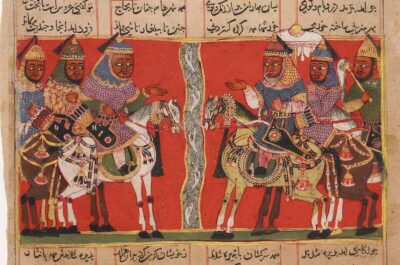
The study is a fairly recent development in Indian history as earlier historians used to believe that Delhi Sultanate didn’t had any form of painting tradition due to religious policies of Sultans. They were somewhat right to believe in this because while the so-called Sultanate spans across c. 1206 CE to c. 1526 CE, and the manuscripts discovered in 80s and 90s containing paintings do not go further back than 1450s.
Literary evidence do talks about paintings being made in the Capital. Books like Tarikh-i-Feroze Shahi and Futuhat-i-Feroze Shahi shows the iconoclastic approach of Sultans with the banning and destruction of paintings. This indirectly also proved the existence of an artistic tradition. Other literary proof comes from works of Vidyapati and long poems like Chhitari Varta, in which they talk about a community of painters in Yoginipura (Delhi). The last proof was the subsequent discovery of some pre-Mughal manuscripts containing miniature paintings. Let’s look at the art styles they have.
Indo-Persian Style Paintings
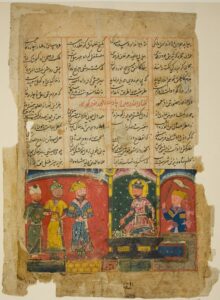
The paintings of that period was not centrally funded by an imperial organization like it was in Royal Atelier of Mughal, still the illustrations we find are done in an Indo-Persian style. It shows that the Afghan-Persian elites were commissioning these scripts from the local artists. Some of the examples of these are :-
Shahnama (book of kings), it was created under Lodi rule and has striking resemblance with Jain style of paintings. This depicts a history of Islamic Kings and is now situated in various museums of Europe.
Ni’mat Nama, a book of recipes and the first identified manuscript of this period. It depicts the Sultan surrounded by people preparing foods, medicines and aphrodisiac.
Khamsa, it is the retelling of Nizami’s stories by the famous Amir Khusrau Dihlavi. A series of 5 illustrious books filled with poems and drawings.
Chandayan, the paintings shows adventurous life of lovers Chanda and Laurak, written in Avadhi in Persian script. It is seen as a perfect blend of Indo-Persian style that will inspire Mughal Paintings.
Features
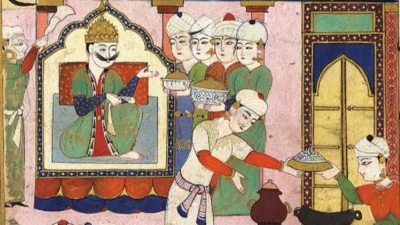
Bureaucratic elite trying to imitate the culture of Persians still required the cooperation of Indian artisans, therefore giving birth to a mashup. These are collectively called Shirazi model of art and another model called Lodi Khuladar.
The manuscripts are usually arranged in vertical formats with horizontal illustrations. The Persian influence is seen in thick green landscapes, pale-soft color for luminous background, depictions of authority figures and decorations around borders. The Indian additions in these pictures are stylization of trees and water, depictions of Indian ladies who were part of their harem, and depiction of groups standing in rows in similar poses.
Jainesque Style Paintings
These are the style of art that do not follow Persian influence and continues the work of earlier conservative form of Art in India. As earlier discussed, there was no unifying force for creation of paintings, resulting in the existence of several different styles in the capital. There are as many as 4 complete manuscripts that writes Yoginipura as it’s place of creation.
Kalakacharyakatha, a Svetambar Jain scripture. It is India’s one of the oldest illustrated manuscript on paper c. 1366 CE, during the reign of Firoz Shah Tughlaq
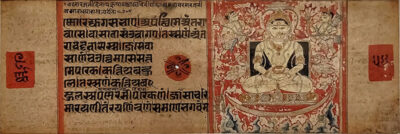
Adipurana, a Digambar Jain manuscript. It has the illustrations showing sixteen lucky dreams of Marudevi.
Mahapurana, another Digambar Jain work. It illustrates stories and teachings of Jain Tirthankar, currently situated in Jaipur.
Bhagvata Purana, a famous Hindu text. Showcasing stories and deeds of Lord Krishna, currently it’s folios are dispersed all over European Museums.
Features
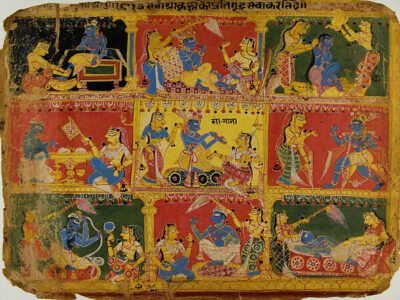
There are probably more manuscripts from this period of Delhi but they are still in debate. The illustrations for above scripts follow a pattern usually seen in western or Apbhramsa school of art. It was originated in Gujrat and Mewar region, and usually derived themes from Jainism and Vaishanvism. The Apbhramsa school had influence in Delhi and adjoining regions before the patronage of late Delhi Sultanate rulers like Lodis or Mughals.
The style of art used in these paintings are called Caurapancasika group style. While the manuscripts were written on palm leaf or papers, the painting style was also heavily used on wall murals decorating palaces and temples. Unlike Persian methods it uses bright colors like red and ochre, yellow and gold for both background and characters. These colors also held symbolic meanings and were supposed to show a single aesthetic. The depictions of human figurines had some unique features like almond shaped/fish shaped eyes, pointy nose and slim waists. They are in stuff expressive gestures with strict and uniform dress codes wearing detailed ornaments.
Conclusion
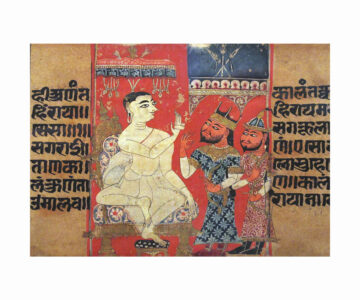
Culturally, Delhi Sultanate was a period of hybrids and fusions in every form of art whether it was in craft, architecture, painting or culinary dish. These experiments with local and foreign elements created new traditions that came to define medieval period. It also contributed to the development of India’s diverse heritage. During the tumultuous period of Mongol Invasions Delhi became the refuge for Iranian and Turkish people. This helped Delhi tremendously to become a cultural hub of art and architecture. The legacy they created became the groundwork of Mughal royal patronage, helping it to flourish even more. Even in modern times the influence are still visible from museums and scholarly work to roadside murals and medias like Krish, Trish and Baltiboy. “Empires inevitably fall, and when they do, history judges them for the legacies they leave behind: Noah Feldman”
Reference
- Digby, Simon. The Literary Evidence for Painting in the Delhi Sultanate. Bulletin of the American Academy of Benares.
- Goswamy, B.N. In the Sultan’s shadow: Pre-Mughal painting in and around Delhi, in R.E. Frykenberg, ed., “Delhi Through the Age: Essays in Urban History, Culture and Society”. Oxford University Press.
- Miniature paintings of India. Lotusarise.com
- Sultanate Painting. Encyclopedia.com
- Painting under sultanate of Delhi. Human.libretexts.org
- Master of the Jainesque Shahnama. Issuu.com




